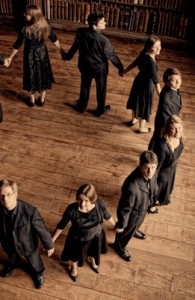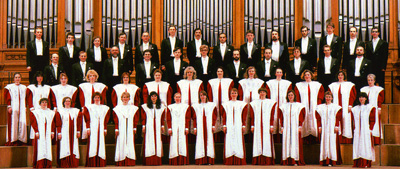Q&A with Stile Antico
When UMS presented Stile Antico two years ago, it was one of the most talked-about events of the season. Stile Antico today is firmly established as one of the most original and exciting new groups in the choral music world. We asked the group a few questions.
1. Stile Antico work together without a conductor. What effect do you think working without a conductor has on the music you produce?
When we founded Stile Antico, we set out to explore the wonderful repertoire of the Renaissance in a new way. Instead of turning up to rehearsals and being told what to do, we wanted to work as chamber musicians – like a string quartet – deciding amongst ourselves how the music should be shaped and performed.
This approach throws a huge responsibility onto the individual singers. In a sense, we are all conductors: we need an extremely high level of collective listening to make sure that we always sing with good blend and ensemble. We also have to feel and react to the overall sound that we are making, at the same time as singing our individual lines. In our early years we sometimes rehearsed with our eyes closed, or facing away from one another, to hone our aural skills!
It also means that each singer has the opportunity to contribute creatively to our performances: we decide everything, from tempo and mood to dynamics and articulation, by discussion and experimentation. This means that we rehearse far more than other groups of our type – perhaps three or four times as much! – but, most importantly, that our interpretations ‘belong’ to the individual singers in a unique way, and (we hope!) that our performances are warmed from the inside, since the ideas that underlie them come from the group itself, rather than a conductor at the front. We can be spontaneous and fluid in performance, responding to one another as the mood takes us, and we find it an enormously rewarding way to work.
2. How do you put together a program in this kind of conductor-less collaborative environment?
As well as sharing in the musical decision-making, everyone in the group has individual roles – looking after our finances, website, travel and so on. There are five members of the group who take a particular lead on musical programming, working intensively on developing themes for future concerts and recordings. But everyone contributes to the discussion – our private website even has a ‘wish-list’ where we can all make repertoire suggestions. We generally have three or four programmes on the go at any one time, and work about two years ahead.
3. It’s often noted that Stile Antico is a group of /young/ singers. Do you have any advice for other aspiring young singers?
According to one of our basses, be a high tenor – they’re always in demand! But more seriously: have plenty of voice lessons. However natural your voice, it’s easy to fall into bad habits, and it’s great to have someone keeping an eye on you as you develop. If you’re considering becoming an ensemble singer, then get as much experience as possible, practice your sight-singing, and listen as widely as you can – the better you understand a particular style, the better you’ll sing it. But most importantly: always remember why you want to be a singer – it’s because you love the music!
4. In the spirit of the approaching holiday season, what is your favourite piece of holiday music to sing together?
In the spirit of collaboration, we discussed this at some length. The most popular option was Tallis’ Videte Miraculum, the ethereal responsory which opens our Puer natus est programme. But one tenor insisted that we record his preference for (his own arrangement of) Frosty the Snowman.
5.What are you looking forward to in your second visit to Ann Arbor?
A friendly and knowledgeable audience – and a return visit to Vinology!
Stile Antico perform at St. Andrew’s Episcopal Church on Wednesday, Dec. 7th.
Public Q&A: Ask Stile Antico
When the young British ensemble Stile Antico performed two years ago, the event was one of the most talked-about that season.
The ensemble is now firmly established as one of the most original and exciting new groups in the choral music world. Working without a conductor, the 12 members of Stile Antico rehearse and perform as chamber musicians, each contributing artistically to the end result. Their performances have been repeatedly praised for their vitality and commitment, expressive lucidity, and imaginative response to text.
Now’s your chance to ask the musicians your questions. Tweet your questions @UMSNews, post them on our Facebook page, or in the comments below.
We’ll post Stile Antico’s response here on the Lobby before they return to perform again on December 7.
11/12 Divine Voices Series
The Divine Voices Series celebrates the choral music tradition with three concerts at St. Francis of Assisi Catholic Church and one in St. Andrews Episcopal Church.
Subscription packages go on sale to the general public on Monday, May 9, and will be available through Friday, September 17. Current subscribers will receive renewal packets in early May and may renew their series upon receipt of the packet. Tickets to individual events will go on sale to the general public on Monday, August 22 (via www.ums.org) and Wednesday, August 24 (in person and by phone). Not sure if you’re on our mailing list? Click here to update your mailing address to be sure you’ll receive a brochure.
State Symphony Capella of Russia
Valery Polyansky, conductor
Thursday, October 13, 7:30pm
St. Francis of Assisi Catholic Church
Featuring 50 glorious voices, the State Symphony Capella of Russia was founded in 1991 as a result of a merger of the USSR State Chamber Choir and the State Symphony Orchestra of the USSR Ministry of Culture. The Capella’s program will include Russian choral works of Bortnianski, Tchaikovsky, Rachmaninoff, Taneyev, Sidelnikov, and Schnittke, as well as works of Anton Bruckner and Russian folk songs.
Schola Cantorum of Venezuela
María Guinand, conductor
Thursday, October 27, 7:30pm
St. Francis of Assisi Catholic Church
Schola Cantorum de Venezuela is one of the most important choral societies belonging to the growing choral movement in Venezuela. The premiere touring chorus of Latin America, the Schola Cantorum has a breathtaking range of repertoire, from sacred hymns and motets to propulsive rhythmic and tuneful popular idioms of their rich Latin American culture. Their Ann Arbor debut program, “Water and Fiesta,” features songs by composers from Venezuela, Brazil, Argentina, Peru, Colombia, Uruguay, Cuba, Mexico, and the US.
Veni Emmanuel: Tudor music for Christmas and Advent
Stile Antico
Wednesday, December 7, 7:30pm
St. Andrew’s Episcopal Church
For this return engagement, Stile Antico moves across town to the beautiful sanctuary of St. Andrews Episcopal Church, where they will perform a program of Tudor music for Christmas and Advent. The program is centered on Thomas Tallis’s magnificent seven-part “Christmas” mass, written for the combined choirs of the Spanish and English Chapels Royal and first performed in December 1554.
The Tallis Scholars
Peter Phillips, artistic director
Thursday, Feburary 16, 7:30pm
St. Francis of Assisi Catholic Church
The Tallis Scholars add a new dimension to UMS’s focus on artistic renegades, by presenting music of the wealthy Italian prince Carlos Gesualdo, most famous for his obsessive double murder of his wife and her lover, but also a maverick Renaissance composer whose eccentric approach to creating music and whose colorful life story inspired both Nadia Boulanger and Igor Stravinsky several hundred years later. At the centerpiece of this program is the Tenebrae Responses, the liturgy for the final three days of Holy Week. Works by other “maverick” Renaissance composers round out the program.
Return to the complete chronological list.




